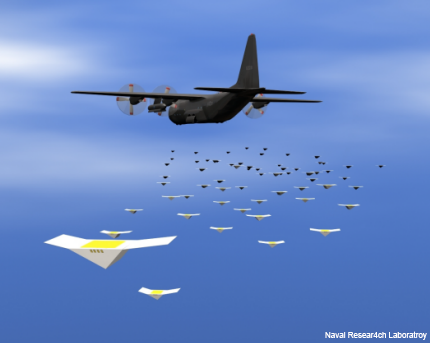Technology takes center stage at DOD Lab Day
The Army and Navy preview the technologies to be displayed at the event, which seeks to increase awareness of research projects and tech-centric successes.

A depiction of NRL’s CICADA unmanned gliders.
The Pentagon grounds will be crawling with innovative technologies Thursday, as the service’s research and development arms take part the Defense Department’s Lab Day.
When the event was first announced, the Air Force Research Laboratory announced some of the 26 technologies it would have on display. AFRL’s counterparts in the Army and Navy also have offered a glimpse of what they’ll be showing off.
One of the items the Army plans to showcase the Concept for Advanced Military Explosion-mitigating Land Demonstrator, or CAMEL, described as “a nontraditional Army Ground Vehicle Survivability Demonstrator, designed and optimized with the latest advancement in armor and protection for the safety and survivability of the occupants.”
An Evolution of Night Vision Technology interactive will provide an illustrative display of digital imagery and symbology that has been networked with the warfighter's night vision capabilities. And the Army also stage another set of interactive displays, with Tunnel/Subterranean Detection Technologies to inform participants about the Army’s perimeter security at home and in conflict zones globally, and a display of its High Energy Laser, that will showcase the progress made in developing solid state/fiber-optic directed-energy technology.
The Naval Research Lab, meanwhile has also provided a short list of technology it will feature on the Pentagon’s courtyard, including:
- Vantage, an airborne, unmanned platform to support electronic warfare and intelligence, surveillance, and reconnaissance missions.
- CICADA, an unmanned glider that, once released, is nearly undetectable and delivers payloads to precise waypoints.
- Helmet Modifications to Mitigate Traumatic Brain Injury, featuring NRL’s latest designs for protecting service members.
- WindSat, a large satellite, in orbit today, that provides ocean surface wind vector measurements and other environmental parameters to help improve weather predictions.
These items are in addition to AFRL’s Automatic Ground Collision Avoidance System (Auto GCAS), the Battlefield Air Targeting Man-Aided Knowledge (BATMAN), the Directed Energy and Electro-Optics for Space Superiority (DEOSS) and the Android Tactical Assault Kit (ATAK), among other technologies.